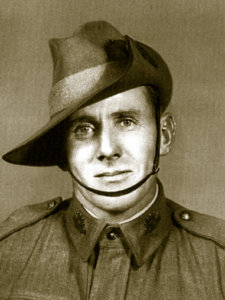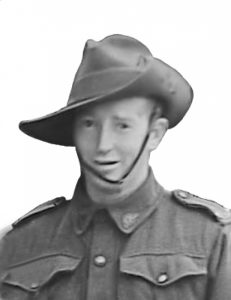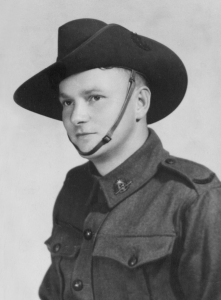Kawasaki 14D - Shibaura or No. 14 Branch Camp, Tokyo
It was at this camp Climie and Clayden and a small number of ‘Rakuyo’ Maru survivors were sent to work. (approx 80 survivors in three sea worthy craft were picked up by a Japanese naval corvette 2-3 days after ‘Rakuyo’ Maru sank – and taken to Moji – 40 of these including Bert Wall from 2/4th sent to Sakata to work) and some to this camp.
 Right: Corporal ‘Aussie’ Climie WX4927 was killed in an allied air raid on 7 July 1945. He was one of at least 8 Australian killed.
Right: Corporal ‘Aussie’ Climie WX4927 was killed in an allied air raid on 7 July 1945. He was one of at least 8 Australian killed.
‘Aussie’ was a Kalgoorlie born boy, who enlisted at Carnarvon July 1940, later joined 2/4th’s ‘C’ Coy and survived the desperate fighting at Hill 200, Ulu Pandan 12 Feb, 1942 – where so many of 2/4th were killed. Aussie left Singapore with ‘A’ Force Green Force No. 3 Battalion to work on the Burma end of the Burma-Thai Railway. With Clayden and Wall he survived. They were deemed fit by the Japanese and selected to work in Japan. The three men survived the sinking of ‘Rakuro’ Maru for about 3 days before being picked up by the Japanese corvette.

Both WX10358 Sydney Richard Clayden and WX12989 Herbert ‘Bert’ John Wall (below) survived to return home. Clayden was recovered from Shingawa Main Hospital Camp.

We wish to acknowledge and than Taeko Sasamoto (Ms), secretary-general of POW Research Network Japan for forwarding up the following information about this camp(s).
GHQ/SCAP records on Tokyo No.14 Branch Camp (Former Tokyo No.11 Dispatched Camp) where Clime and Claydon were interned. The location of this camp was changed four times.
When the camp was destroyed by air raid on 13th July 1945, the camp was located at Toshiba factory, Suehiro-cho, Tsurumi-ku, Yokohama City and the latitude/longitude was 35°29′15″ N 139°41′55″ E.
At the end of September 1944, 50 Australians including Clime and Clayden, who survived from Rakuyo Maru sinking, were interned in this camp. 25 of them were transferred to Niigata Camp in June 1945, before the air raid.
At the end of war, there were 121 POWs (72 Dutch, 20 British, 17 Australian and 12 American) in this camp.
44 POWs died while imprisonment, 31 of whom were killed in the air raids.
Although the Camp Location changed four times – they were mostly in the heavily populated industrial area of Yokohama and Kawasaki. POWs worked at Tokyo Shibaura Electric Company Limited Tsurumi Works located at Yokohama,Tsurumi-ku, Suchiro-cho.
Below: information contained in the Allied Investigation Division’s report of June 1946.







Unfortunately we did not receive the last lines of the above page.
Imagine the terror in the barracks during those air raids – the POWs forbidden to leave their wooden constructed barracks during Allied air raids – Japanese guards ensuring they remained.




The last line to read: ‘ascertain which cases without additional statements from POWs.’
At the end of war, there were 121 POWs (72 Dutch, 20 British, 17 Australian and 12 American) in this camp.
44 POWs died while imprisonment, 31 of whom were killed in the air raid.

Soldiers that were in this camp
Location of Kawasaki 14D - Shibaura or No. 14 Branch Camp, Tokyo
 Right: Corporal ‘Aussie’ Climie WX4927 was killed in an allied air raid on 7 July 1945. He was one of at least 8 Australian killed.
Right: Corporal ‘Aussie’ Climie WX4927 was killed in an allied air raid on 7 July 1945. He was one of at least 8 Australian killed.













